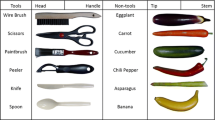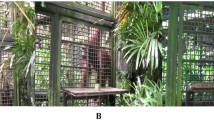Abstract
Few studies have examined whether non-human tool-users understand the properties that are relevant for a tool's function. We tested cotton-top tamarins (Saguinus oedipus) and rhesus macaques (Macaca mulatta) on an expectancy violation procedure designed to assess whether these species make distinctions between the functionally relevant and irrelevant features of a tool. Subjects watched an experimenter use a tool to push a grape down a ramp, and then were presented with different displays in which the features of the original tool (shape, color, orientation) were selectively varied. Results indicated that both species looked longer when a newly shaped stick acted on the grape than when a newly colored stick performed the same action, suggesting that both species perceive shape as a more salient transformation than color. In contrast, tamarins, but not rhesus, attended to changes in the tool's orientation. We propose that some non-human primates begin with a predisposition to attend to a tool's shape and, with sufficient experience, develop a more sophisticated understanding of the features that are functionally relevant to tools.







Similar content being viewed by others
References
Boesch-Achermann H, Boesch C (1993) Tool use in wild chimpanzees: new light from dark forests. Curr DirPsychol Sci 2:18–21
Brown A (1990) Domain-specific principles affect learning and transfer in children. Cogn Sci 14:107–133
Chappell J, Kacelnik A (2002) Tool selectivity in a non-primate, the New Caledonian crow (Corvus moneduloides). Anim Cogn 5:71–78
Hauser MD (1997) Artifactual kinds and functional design features: what a primate understands without language. Cognition 64:285–308
Hauser MD (1998) A nonhuman primate's expectations about object motion and destination: the importance of self-propelled movement and animacy. Dev Sci 1:31–38
Hauser MD (2000) Wild minds: what animals really think. Holt, New York
Hauser MD (2001) Searching for food in the wild: a nonhuman primate's expectations about invisible displacement. Dev Sci 4:84 – 93
Hauser MD, Carey S (1998) Building a cognitive creature from a set of primitives: evolutionary and developmental insights. In: Cummins D, Allen C (eds) The evolution of mind. . Oxford University Press, Oxford, pp 51–106
Hauser MD, Perry S, Manson J, Ball H, Williams M, Pearson E, Berard J (1991) It's all in the hands of the beholder: new data on handedness in a free-ranging population of rhesus macaques. Behav Brain Sci 14:342–344
Hauser MD, MacNeilage P, Ware M (1996) Numerical representations in primates. Proc Natl Acad Sci 93:1514–1517
Hauser MD, Kralik J, Botto-Mahan C (1999) Problem solving and functional design features: experiments on cotton-top tamarins (Saguinus oedipus). Anim Behav 57:565–582
Hauser MD, Pearson HM, Seelig D (2002) Ontogeny of tool-use in cotton-top tamarins (Saguinus oedipus): innate recognition of functionally relevant features. Anim Behav 64:299–311
Hood BM, Hauser MD, Anderson L, Santos L (1998) Gravity biases in a nonhuman primate? Dev Sci 1:35–41
Matsuzawa T (1994) Field experiments on use of stone tools by chimpanzees in the wild. In: Wrangham RW, McGrew WC, de Waal FBM, Heltne PG (eds) Chimpanzee cultures. Harvard University Press, Cambridge, Mass., pp 351–370
McGrew WC (1992) Chimpanzee material culture: implications for human evolution. Cambridge University Press, Cambridge
McGrew WC (1994) Tools compared: the material of culture. In: Wrangham RW, McGrew WC, de Waal FBM, Heltne PG (eds) Chimpanzee cultures.Harvard University Press, Cambridge, Mass., pp 25–40
Munakata Y, Santos LR, Spelke ES, Hauser MD, O'Reilly RC (2001) Visual representation in the wild: how rhesus monkeys parse objects. J Cogn Neurosci 13:44–58
Povinelli DJ (2000) Folk physics for apes. Oxford University Press, Oxford
Rawlins RG, Kessler MG (1987) The Cayo Santiago Macaques: history, behavior, and biology. SUNY Press, Albany
Santos LR (1997) Precursors to a theory of mind: insights from a nonhuman primate. Unpublished honors thesis, Harvard University, Cambridge, MA
Santos LR (2003) "Core knowledges": a dissociation between looking and searching in a non-human primate. Dev Sci (in press)
Santos LR, Hauser MD (1999) How monkeys see the eyes: cotton-top tamarins' reaction to changes in visual attention and action. Anim Cogn 2:131–139
Santos LR, Hauser MD (2002) A nonhuman primate's understanding of solidity: dissociations between seeing and acting. Dev Sci 5:F1-F7
Santos LR, Ericson BN, Hauser MD (1999) Constraints on problem solving and inhibition: object retrieval in cotton-top tamarins (Saguinus oedipus oedipus). J Comp Psychol 113:186–193
Santos LR, Hauser MD, Spelke ES (2001) Recognition and categorization of biologically significant objects by rhesus macaques (Macaca mulatta): the domain of food. Cognition 82:127–155
Santos LR, Sulkowski GM, Spaepen GM, Hauser MD (2002) Object individuation using property/kind information in rhesus macaques (Macaca mulatta). Cognition 83:241–264
Spelke ES (1985) Preferential-looking methods as tools for the study of cognition in infancy. In: Gottlieb G, Krasnegor NA (eds.) Measurement of audition and vision in the first year of postnatal life: a methodological overview. Ablex, Stamford, Conn., pp 323–363
Spelke ES (1991) Physical knowledge in infancy: reflections on Piaget's theory. In: Carey S, Gelman R (eds) The epigenesis of mind: essays on biology and cognition. Erlbaum, Hillsdale, NJ, pp 37–61
Tomasello M, Call J (1997) Primate cognition. Oxford University Press, Oxford
Uller MC (1997) Origins of numerical concepts: a comparative study of human infants and nonhuman primates. Doctoral dissertation, Massachusetts Institute of Technology. Diss Abstr Int Sect B Sci Eng 58:3-B
Uller C, Xu F, Carey S, Hauser MD (1997) Is language needed for constructing sortal concepts? A study with nonhuman primates. In: Hughes E (ed.) Proceedings of the 21st Annual Boston University Conference on Language Development, pp 665–677
Uller C, Hauser MD, Carey S (2001) Spontaneous representation of number in cotton-top tamarins (Saguinus oedipus). J Comp Psychol 115:248–257
Visalberghi E, Limongelli L (1994) Lack of comprehension of cause-effect relations in tool-using capuchin monkeys (Cebus apella). J Comp Psychol 108:15–22
Visalberghi E, Tomasello M (1998) Primate causal understanding in the physical and psychological domains. Behav Process 42:189–203
Visalberghi E, Trinca L (1989) Tool use in capuchin monkeys: distinguishing between performance and understanding. Primates 30:511–521
West RE, Young RJ (2002) Do domestic dogs show any evidence of being able to count? Anim Cogn 5:183–18
Westergaard GC, Suomi SJ (1995) The stone tools of capuchins (Cebus apella). Int JPrimatol 16:1017–1024
Whiten A, Goodall J, McGrew WC, Nishida T, Reynolds V, Sugiyama Y, Tutin CEG, Wrangham RW, Boesch C (1999) Cultures in chimpanzees. Nature 399:682–685
Acknowledgements
L.R.S. was supported by the Mind, Brain, and Behavior Program, the Harvard University McMasters Fund, the Mellon Scholars Program, and an NSF Predoctoral Fellowship. C.T.M. was supported by Harvard University. M.D.H. was supported by the NSF (SBR-9357976), the NEPRC (PHS-P51RR00168–37) and Harvard University. Cayo Santiago was supported by the University of Puerto Rico, Medical Sciences Campus and NIH (# RR03640). The authors wish to thank Kate Dollenmayer, Orville Jackson, Dr. Lori Markson, and Bridget Spelke for their help in running these experiments, and Dr. John Berard and the Caribbean Primate Research Center for the use of the Cayo Santiago facilities. We also wish to thank Dr. Paul Bloom, Dr. Asif Ghazanfar, and Dr. Elizabeth Spelke for their insightful comments on the manuscript. All of this research conforms to federal guidelines for use of animals in research.
Author information
Authors and Affiliations
Corresponding author
Rights and permissions
About this article
Cite this article
Santos, L.R., Miller, C.T. & Hauser, M.D. Representing tools: how two non-human primate species distinguish between the functionally relevant and irrelevant features of a tool. Anim Cogn 6, 269–281 (2003). https://doi.org/10.1007/s10071-003-0171-1
Received:
Revised:
Accepted:
Published:
Issue Date:
DOI: https://doi.org/10.1007/s10071-003-0171-1




